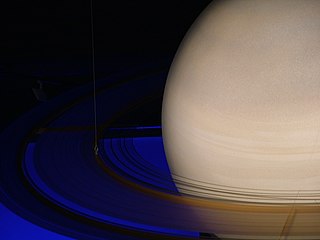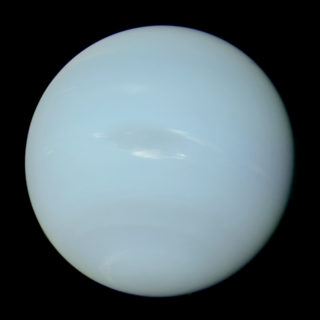
Voyager 2 is a space probe launched by NASA on August 20, 1977, to study the outer planets and interstellar space beyond the Sun's heliosphere. As a part of the Voyager program, it was launched 16 days before its twin, Voyager 1, on a trajectory that took longer to reach gas giants Jupiter and Saturn but enabled further encounters with ice giants Uranus and Neptune. Voyager 2 remains the only spacecraft to have visited either of the ice giant planets, and was the third of five spacecraft to achieve Solar escape velocity, which allowed it to leave the Solar System.

Uranus is the seventh planet from the Sun. It is a gaseous cyan-coloured ice giant. Most of the planet is made of water, ammonia, and methane in a supercritical phase of matter, which in astronomy is called 'ice' or volatiles. The planet's atmosphere has a complex layered cloud structure and has the lowest minimum temperature of 49 K out of all the Solar System's planets. It has a marked axial tilt of 82.23° with a retrograde rotation period of 17 hours and 14 minutes. This means that in an 84-Earth-year orbital period around the Sun, its poles get around 42 years of continuous sunlight, followed by 42 years of continuous darkness.

Titania, also designated Uranus III, is the largest of the moons of Uranus and the eighth largest moon in the Solar System at a diameter of 1,578 kilometres (981 mi), with a surface area comparable to that of Australia. Discovered by William Herschel in 1787, it is named after the queen of the fairies in Shakespeare's A Midsummer Night's Dream. Its orbit lies inside Uranus' magnetosphere.

An ice giant is a giant planet composed mainly of elements heavier than hydrogen and helium, such as oxygen, carbon, nitrogen, and sulfur. There are two ice giants in the Solar System: Uranus and Neptune.
The New Frontiers program is a series of space exploration missions being conducted by NASA with the purpose of furthering the understanding of the Solar System. The program selects medium-class missions which can provide high science returns.

The exploration of Uranus has, to date, been through telescopes and a lone probe by NASA's Voyager 2 spacecraft, which made its closest approach to Uranus on January 24, 1986. Voyager 2 discovered 10 moons, studied the planet's cold atmosphere, and examined its ring system, discovering two new rings. It also imaged Uranus' five large moons, revealing that their surfaces are covered with impact craters and canyons.

The exploration of Saturn has been solely performed by crewless probes. Three missions were flybys, which formed an extended foundation of knowledge about the system. The Cassini–Huygens spacecraft, launched in 1997, was in orbit from 2004 to 2017.

Neptune has been directly explored by one space probe, Voyager 2, in 1989. As of 2024, there are no confirmed future missions to visit the Neptunian system, although a tentative Chinese mission has been planned for launch in 2024. NASA, ESA, and independent academic groups have proposed future scientific missions to visit Neptune. Some mission plans are still active, while others have been abandoned or put on hold.

Neptune is the eighth and farthest known planet from the Sun. It is the fourth-largest planet in the Solar System by diameter, the third-most-massive planet, and the densest giant planet. It is 17 times the mass of Earth, and slightly more massive than fellow ice giant Uranus. Neptune is denser and physically smaller than Uranus because its greater mass causes more gravitational compression of its atmosphere. Being composed primarily of gases and liquids, it has no well-defined solid surface. The planet orbits the Sun once every 164.8 years at an orbital distance of 30.1 astronomical units. It is named after the Roman god of the sea and has the astronomical symbol , representing Neptune's trident.

The Planetary Science Decadal Survey is a serial publication of the United States National Research Council produced for NASA and other United States Government Agencies such as the National Science Foundation. The documents identify key questions facing planetary science and outlines recommendations for space and ground-based exploration ten years into the future. Missions to gather data to answer these big questions are described and prioritized, where appropriate. Similar decadal surveys cover astronomy and astrophysics, earth science, and heliophysics.

Uranus Pathfinder was a mission concept for the Uranian system evaluated in the 2010s by the European Space Agency. In 2011, scientists from the Mullard Space Science Laboratory in the United Kingdom proposed the joint NASA–ESA Uranus Pathfinder mission to Uranus. It would have been a medium-class (M-class) mission to be launched in 2022, and was submitted to the ESA in December 2010 with the signatures of 120 scientists from around the globe. ESA caps the cost of M-class missions at €470 million. Uranus Pathfinder was proposed in support of ESA's Cosmic Vision 2015–2025. The mission study including several possible combinations of launch dates, trajectories, and flybys, including flybys of Earth, Venus, and of the planet Saturn. Indeed, the study noted the velocity change requirements are only marginally higher than for typical missions to Saturn of this period.

ODINUS is a space mission concept proposed to the European Space Agency's Cosmic Vision programme. The ODINUS mission concept proposes to expand the Uranus orbiter and probe mission to two twin orbiters— dubbed Freyr and Freyja, the twin gods of the Norse pantheon. Their primary mission would be to study Neptune and Uranus with one orbiter each. If selected, ODINUS would launch in 2034.
MUSE is a European proposal for a dedicated mission to the planet Uranus to study its atmosphere, interior, moons, rings, and magnetosphere. It is proposed to be launched with an Ariane 6 in 2026, travel for 16.5 years to reach Uranus in 2044, and would operate until 2050.
The following outline is provided as an overview of and topical guide to Uranus:

The Europa Lander is a proposed astrobiology mission concept by NASA to send a lander to Europa, an icy moon of Jupiter. If funded and developed as a large strategic science mission, it would be launched in 2027 to complement the studies by the Europa Clipper orbiter mission and perform analyses on site.

The Ocean Worlds Exploration Program (OWEP) is a NASA program to explore ocean worlds in the outer Solar System that could possess subsurface oceans to assess their habitability and to seek biosignatures of simple extraterrestrial life.

OCEANUS is a mission concept conceived in 2016 and presented in 2017 as a potential future contestant as a New Frontiers program mission to the planet Uranus. The concept was developed by the Astronautical engineering students of Purdue University during the 2017 NASA/JPL Planetary Science Summer School. OCEANUS is an orbiter, which would enable a detailed study of the structure of the planet's magnetosphere and interior structure that would not be possible with a flyby mission.

Neptune Odyssey is an orbiter mission concept to study Neptune and its moons, particularly Triton. The orbiter would enter into a retrograde orbit of Neptune to facilitate simultaneous study of Triton and would launch an atmospheric probe to characterize Neptune's atmosphere. The concept is being developed as a potential large strategic science mission for NASA by a team led by the Applied Physics Laboratory at Johns Hopkins University. The current proposal targets a launch in 2033 using the Space Launch System with arrival at Neptune in 2049, although trajectories using gravity assists at Jupiter have also been considered with launch dates in 2031.

The Enceladus Orbilander is a proposed NASA Flagship mission to Saturn's moon Enceladus. The Enceladus Orbilander would spend a year and a half orbiting Enceladus and sampling its water plumes, which stretch into space, before landing on the surface for a two-year mission to study materials for evidence of life. The mission, with an estimated cost of $4.9 billion, could launch in the late 2030s on a Space Launch System or Falcon Heavy with a landing in the early 2050s. It was proposed in the 2023–2032 Planetary Science Decadal Survey as the third highest priority Flagship mission, after the Uranus Orbiter and Probe and the Mars Sample Return program.
















